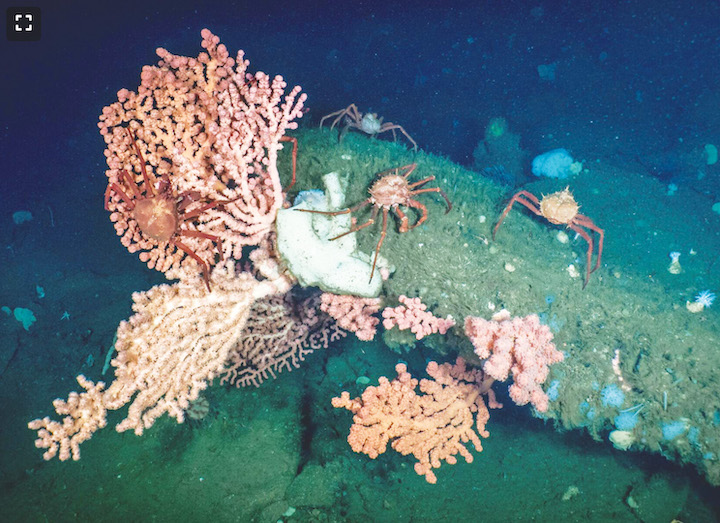In 1990, when Monterey Bay was nominated for consideration as a National Marine Sanctuary, some of the more radical supporters proposed a boundary extending almost to Point Conception. Three decades later, that vision may become a reality. And the effort is led by Chumash Natives, the Central Coast’s original ocean stewards.
The proposed Chumash Heritage National Marine Sanctuary (CHNMS) would stretch from the southern end of the Monterey Bay National Marine Sanctuary to the Channel Islands National Marine Sanctuary, creating an unbroken protected marine area of almost 15,000 square miles. The National Oceanic and Atmospheric Administration (NOAA) hopes to complete designation by the winter of 2023.
“The idea of calling it the Chumash Heritage National Marine Sanctuary is a form of recognition for all those people, both past and present, who have not been recognized before as natives by the federal government,” explains Bear Clan elder Michael Khus-Zarate. “If the proposed sanctuary is designated, it will be a magnet for further revitalization of Chumash people throughout the Central Coast. It’s a way of confirming our continued existence as well as our continued responsibilities and obligations to be caretakers of the land and water.”
The tribe’s territory once reached from roughly Morro Bay to Malibu, and their advanced ocean-going crafts allowed them to travel along the coast and to the Channel Islands. “The Chumash have a maritime culture and tradition,” explains Khus-Zarate. “Our relationship with the ocean is primarily one of respect and reverence. The ocean helps us understand our proper place in the world, helps us feel humble … We don’t own the land or the waters, it’s not ours to give away or share, it’s ours to caretake.”
Creating a National Marine Sanctuary requires patience and dedication. For over 40 years, marine sanctuaries were proposed by state or federal agencies. In 2015, NOAA opened the process to local communities. After six months of meetings and paperwork, the Northern Chumash Tribal Council nominated the CHNMS; NOAA asked for more detail. Six months later, the NCTC submitted a revised proposal, which was accepted.
“That just put us in the inventory, a little file that says at some point in the future NOAA can decide to start the designation process—or not,” explains PJ Webb, legal advisor to the NCTC.
The CHNMS nomination sat inactive during the Trump administration. After five years, NOAA needed to review it. “We worked hard and got 14,000 comments during the public comment period, with no paid staff, no monetary resources, just blood sweat and tears,” Webb says. “Those comments were overwhelmingly in support of the sanctuary. It kind of blew NOAA out of the water, sometimes there are only 5 or 55 or 100 comments.”
Violet Sage Walker, the chairperson of the NCTC and nominator of the CHNMS, carries on the work of her late father, Fred Collins, who worked to protect Chumash waters for decades. “Most indigenous people feel obligated to continue the traditions of their ancestors,” she explains. “This is not something we can take a break from. We don’t, like, clock out after 40 hours. We are obligated to do this forever, until designation is secured, and then we are obligated to co-manage. We will work on this until we die.”
Sage Walker believes this indigenous perspective was critical in moving forward with the sanctuary. “We bring something to the table nobody else brings,” she explains. “We can talk about spirit and how the ocean is important for people’s spiritual health. This isn’t just about biodiversity, it’s about our soul, our happiness, our healing, our ancestors. That’s what made our nomination stand out among all the other ones.”
Public scoping began November 10, 2021. “NOAA asks for very specific scientific criteria, which only marine biologists can satisfy, but we did our best to translate that into lay persons language,” explains Webb. “The deadline for the scoping process was extended; people who opposed the sanctuary thought it was too short.” In just under three months, between 25,000-30,000 comments were generated. “The overwhelming majority, over 90%, were in support of the sanctuary,” says Webb. “And that happened in the middle of a pandemic, over Christmas and New Years.”
The main opposition comes from people in the fishing industry who worry about how sanctuary status and federal oversight will affect their livelihoods. But fishing regulations inside a marine sanctuary are identical to regulations outside of a sanctuary, and the federal government already oversees the oceans.
“We are facing a campaign of misinformation,” says Sage Walker with a frustrated sigh. “People need better education. There is no local control of the ocean. The federal government already controls everything from mean high tide out to the high seas. The marine sanctuary will not change that.”
“There is no reason not to designate the marine sanctuary, there are no drawbacks,” continues Sage Walker. “There are no competing interests, we all want to protect the ocean. I don’t think fishermen or wind energy should be opposed to conservation. No users of ocean or land should be oppositional. We all have the same interests, to prolong our quality of life on this planet.”
The Chumash pushing for marine sanctuary status join marginalized communities all over the planet working to enhance life on Earth. “Indigenous people, people in third world countries, people of color, we will be the first displaced by climate change, so we are the most committed to fighting it,” says Sage Walker. “Because we are protecting our heritage, our ancestors, our families, our homeland, our way of life. We have more skin in the game than anybody else, so we have to fight harder than anybody else. It’s because we love it that we have to do this. And not a single one of us is backing down from the challenge.”













